MONDAY
JULY 30 - 2012
BROOK
MEADOW
The first round pink
flowers of Strawberry Clover are now showing
well on the path around the Lumley area. This is the
only area they grow on Brook Meadow.
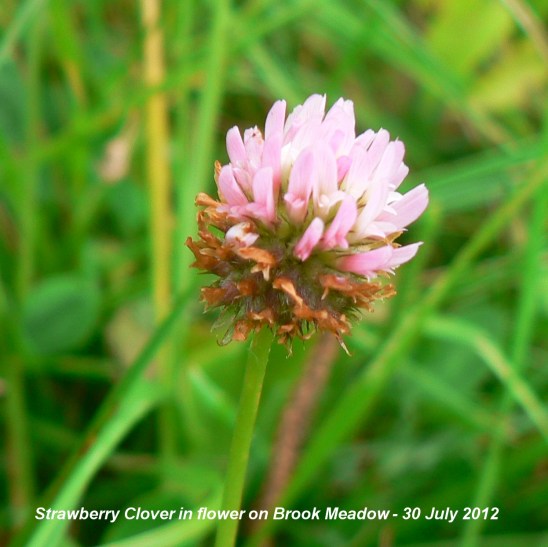
I was lucky to come
across a Comma resting on a leaf on the Lumley
area. I managed to get a photo without disturbing it.
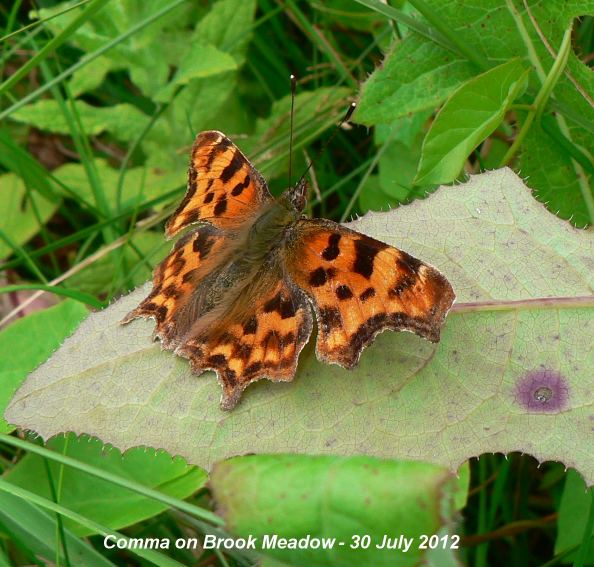
BTO
BREEDING BIRDS SURVEY REPORT
Breeding
waders down
The latest figures
from the Breeding Bird Survey (BBS) show that four of
our breeding waders have reached their lowest levels
since the survey started in the early 1990s. Volunteer
birdwatchers reported particularly low numbers of
Lapwing, Oystercatcher, Snipe and Curlew during the
spring of 2011.
These birds breed on
wet grassland and upland habitats throughout the UK,
where they rely on earthworms and other invertebrates
for food, and previous declines have been blamed on
habitat loss, land drainage and potential increases in
predation pressure. All four species, however, saw
sharp declines between 2010 and 2011, of 19% for
Oystercatcher, 18% for Lapwing, 40% for Snipe and 13%
for Curlew, which may have been due to unfavourable
weather conditions during the year exacerbating
long-term declines.
The spring of 2012 has
seen the wettest April-to-June period on record, and
it's likely that populations of these ground-nesting
waders would have also been hit hard this year.
Flooding at several key sites has seen hundreds of
wader nests washed out, including 600 at the RSPB's
Ouse Washes reserve in Cambridgeshire.
Ten
species in serious decline
The BBS produces
annual population trends for over one hundred of our
widespread bird species. While many birds are
thriving, ten species have declined by more than 50%
since the start of the survey in 1994, including
Turtle Dove, which has declined by a staggering 80%.
Since the start of the survey we have lost more than
half of the following ten species:
Turtle Dove
-80%
Willow Tit
-79%
Wood Warbler
-65%
Whinchat
-57%
Grey Partridge
-55%
Nightingale
-52%
Yellow Wagtail
-50%
Pied Flycatcher
-50%
Spotted Flycatcher
-50%
Starling
-50%
This list emphasises
declines in farmland and woodland birds, and of
migrants; all but three of the birds in this list
(Willow Tit, Grey Partridge and Starling) migrate to
Africa for the winter.
Skylark
decline
The decline in Skylark
numbers has accelerated in recent years, with a
significant 7% decline between 2010 and 2011 of this
familiar farmland bird, compounding the 20% decline
since the start of the survey in 1994. Skylarks had
already suffered substantial declines in the 1970s,
leading to this species' red-listing as a bird of
conservation concern.
Tree
Sparrows recover
Encouragingly, the
latest trends show that Tree Sparrows are continuing
their recent increase. Once common, Tree Sparrows
declined dramatically during the 1980s, and numbers
today are still extremely low in comparison with the
past. However, the small remaining population appears
to have stabilised in patches of suitable habitat, and
this these increases, while small compared to previous
declines, are to be welcomed.
FRIDAY
JULY 27 - 2012
BROOK
MEADOW
Beautiful
Demoiselle
I spent the whole
afternoon up dating the three display cases on Brook
Meadow with new photos and text. On my way between the
signcases I had an excellent view of a male Beautiful
Demoiselle (Calopteryx virgo) perched on vegetation
right in front of me on on the river bank opposite the
Bulrushes. it had completely dark blue wings with no
sign of a band. Unfortunately, by the time I got my
camera out it had flown high into a tall Sycamore tree
on the other side of the river, making a photo with my
12x zoom camera almost impossible. But here is what I
got, clearly a Beautiful Demoiselle.
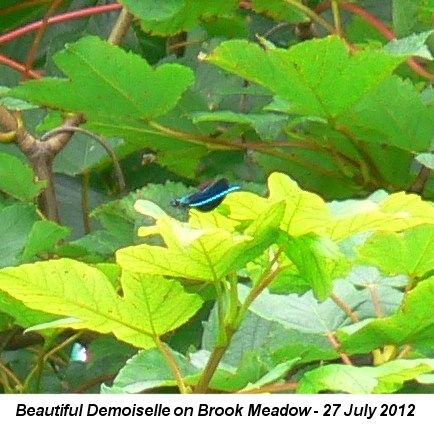
The only other
Beautiful Demoiselle sighting on Brook Meadow this
year was by Malcolm Phillips on June 2.
THURSDAY
JULY 26 - 2012
SLIPPER
MILLPOND
Plant
survey
I went down to Slipper
Millpond this morning at the request of Gavin Miller
to help him identify some new plants that had come on
an area of disturbed ground where the association had
planted a small hedgerow on the east side of the pond.
The plants were similar to those seen on the disturbed
area on the Seagull Lane patch on Brook Meadow with
Fat Hen, Scentless Mayweed, Fool's Parsley, Scarlet
Pimpernel etc. However, one of the residents had also
scattered 'wild flower' seeds on the area resulting in
a number of exotic plants.
White
Creeping Thistle
I learned something
new this morning about Creeping Thistles. Gavin
pointed out a number of Creeping Thistle plants with
white flowers. My first thought was that these florets
were probably just dying off, but they all looked
healthy and just like the normal flowers except that
they were white. Francis Rose came to the rescue with
the information that the florets of Creeping Thistle
can be mauve or white!
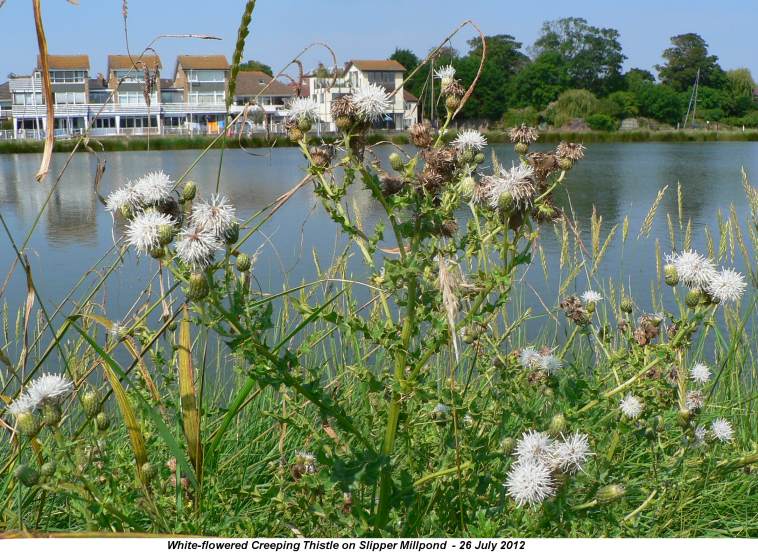
Great
Black-backed Gulls
The two gull chicks
were both on the pond without the parents. They both
flew around the pond for about 30 seconds while I was
there, but settled back on the pond again. Clearly,
they are not ready to venture any further at the
moment, but it cannot be long before they do.
BROOK
MEADOW
There were plenty of
butterflies on the wing this afternoon, including
Meadow Brown, Gatekeeper, Small Skipper, Comma, Red
Admiral, Here is a nice Comma showing how it got its
name.

There is a veritable
'forest' of Hogweed on the north meadow.
Interestingly, Hogweed has both upper and lower
bracts, though the lower ones are missing on some
flower heads.
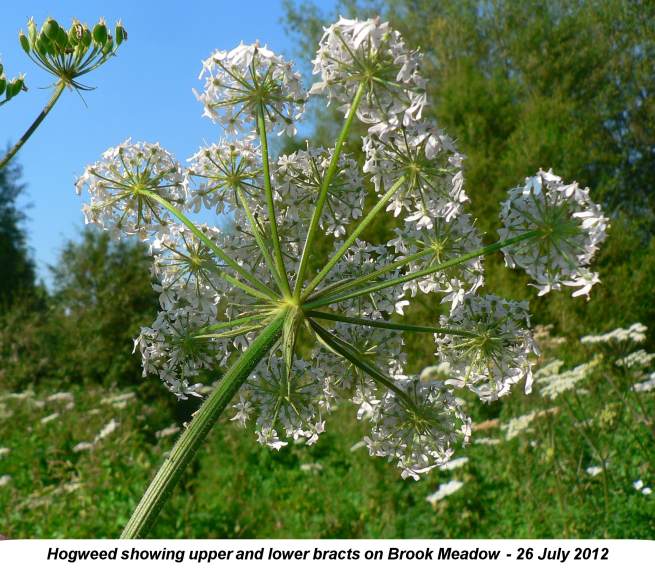
Wild Angelica is
flowering on the Lumley area, much later than last
year. Common Fleabane is now in full flower and
looking quite splendid. There is a very good growth of
False Brome on the north path, the best on Brook
Meadow.

SWIFTS
Parties of up to 10
Swifts have been flying around the houses in Bridge
Road over the past week, occasionally screaming low in
family parties. I doubt that these are local breeders,
but rather birds fattening up on the glut of insects
in our region before their long journey. The fine
weather has probably delayed their migration.
WEDNESDAY
JULY 25 2012
Waste
ground north of Emsworth Railway Station
This morning I did a
quick plant survey of the waste ground between
Emsworth Railway Station and the A27 road embankment
immediately north of the new ramp. Part of the area
has been disturbed by contractors vehicles during the
construction of the new ramp and is largely bare
ground with some rubble, but the surrounding area to
the north and the east still retains its original
vegetation.

The soil is clearly
low in nutrients which means the ground supports a
very good variety of wild flowers, including the best
crop of Marsh Woundwort that I have ever seen
in the local area. I counted around 200 flowering
spikes, all as good as any orchids In total I logged
56 plants (not including tree and shrubs) which is
pretty good for a single visit. With regular surveys
throughout the year I would expect this total to
exceed 100 quite easily.
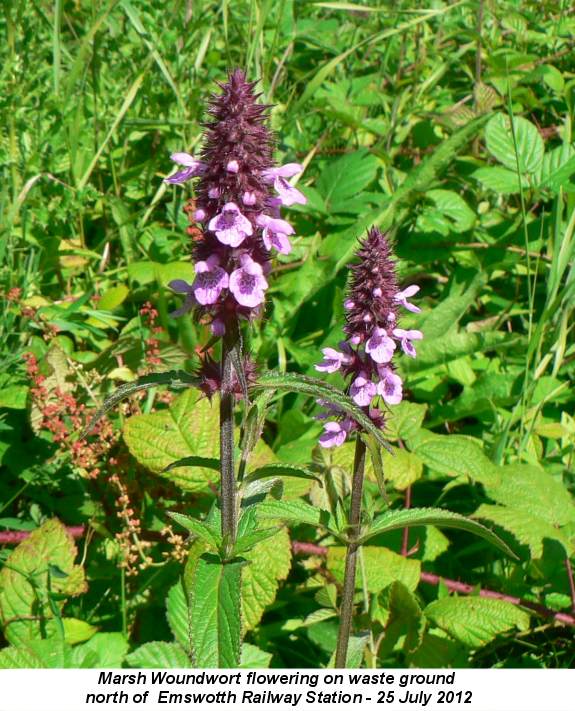
I gather there are
plans to sow 'wild flower seeds' on this site, but it
does not really need them as there is already a
massive native seed bank just waiting to come through.
I would suggest waiting at least a year to see what
native wild flowers colonise from the surrounding
area. It could be a very exciting project and
requiring no maintenance. This would make a very good
addition to the Emsworth waysides project!
Black
Mustard
Thanks to Ralph
Hollins for identifying yet another new plant for our
waysides list. Ralph noted that the yellow flowered
crucifer at the end of the Washington Road path
wayside just before the entrance to the Recreation
Ground had the distinctive short thin seedpods
appressed to the stem characteristic of Black Mustard.
This takes the total number of plants recorded on the
Emsworth waysides since 2009 to 312.
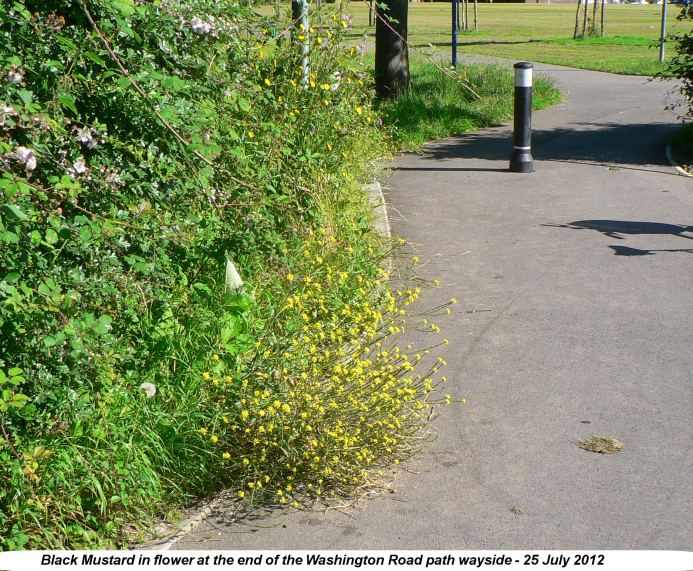
OTHER
NEWS
Southern
Hawker in garden
Mary and Keith Marriot
got this image of a beautiful Southern Hawker
dragonfly in their Westbourne garden on Sunday.
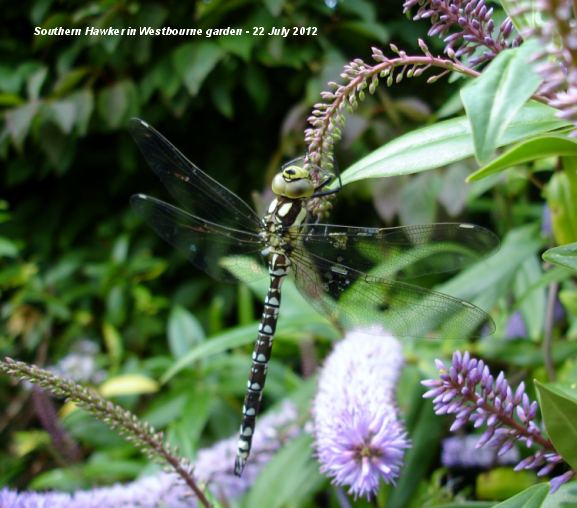
Stag
Beetle in garden
Caroline and Ray
French Ray had a Stag Beetle in their garden, which
was a first for their garden. Caroline watched it for
a good 10 minutes as it crawled around on one of our
plants, then scaled the garage wall and walked across
the roof before finally flexing its wings a few times
and taking off. A handsome insect and a good climber!
What a handsome beast.

A
rare moth in Cowplain
Mike Wells found an
unusual moth on frame of his patio doors of his
Cowplain home yesterday. Eventually, he identified it
as Dewick's Plusia, a rare migrant to this
country.
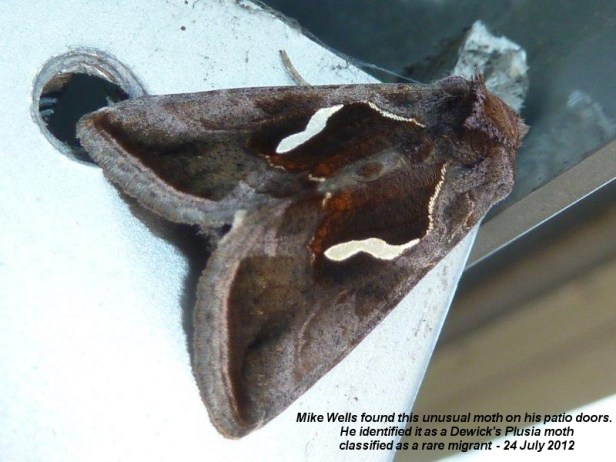
HantsMoths web site
describe it as a rare immigrant from mainland Europe,
appearing in south-eastern England for the first time
at Bradwell-on-Sea, Essex, on 3 October 1951. From
about 1920 it spread rapidly into Western Europe from
the central Palaearctic, and has been seen
increasingly in Britain, especially in the last ten
years. In Hampshire and on the Isle of Wight recorded
for the first time in August 1991, with six in 2007,
11 in 2008 and a minimum of 6 in 2009. Wingspan 32-38
mm. Fairly distinctive. Larva feeds on herbaceous
plants such as Stinging Nettle, Yarrow, Corn
Chamomile, Stinking Chamomile and Wormwood, no
evidence of breeding in the UK. http://www.hantsmoths.org.uk/species/2436.php
UKmoths describe it as
a vagrant to Britain, having occurred only a few dozen
times, mostly attracted to light on the south and east
coasts. August is the optimum month for this species,
but records have occurred between July and October. On
the continent it is double-brooded, and the larvae
feed on a range of plants, most commonly nettle
(Urtica dioica). http://ukmoths.org.uk/show.php?bf=2436
TUESDAY
JULY 24 - 2012
MILLPOND
NEWS
Slipper
Millpond
10:00 - It was all
very quiet and peaceful on the pond this morning. The
two Great Black-backed Gull chicks were
swimming around, they tend to stay fairly close
together. The two adult gulls were also on the pond,
though one did leave while I was there in the
direction of the harbour.
Seven Cormorants
were clustered on the centre raft, chattering away
in their guttural voices. The only other birds on the
pond were the resident Mute Swan pair and three Coot
pairs, plus several Mallard and a small group of
Black-headed Gulls.
A large dragonfly was
constantly hawking near the east bank of the pond
while I was there. I was not able to get a photo but
from its green and blue colouring I would think it was
a Southern Hawker.
Peter
Pond
The Coot family with 4
chicks are still together on Peter Pond. Shoals of
very large Grey Mullett were swimming in the shallow
water while I was there.
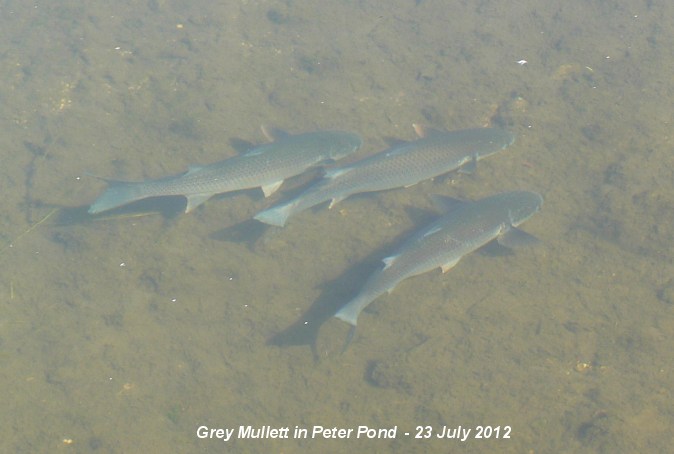
OTHER
NEWS
Butterflies
in Hollybank Woods
Tony Wootton went to
the woods with his U3A group this morning and saw 2
White Admirals and 2 Silverwashed Fritillaries plus a
few Meadow Browns, Red Admirals, Large Whites and 1
Large Skipper. And one common lizard.
Turtle
Dove in Marlpit Lane
Caroline and Ray
French did a butterfly survey on my old BBS square
SU7808 as part of the Wider Countryside Butterfly
Survey. As they were walking along Common Road they
heard a couple of short bursts of Turtle Dove song as
they approached the corner of Marlpit Lane. Caroline's
only encounter with Turtle Dove so far this year. They
certainly have been scarce and I believe Marlpit Lane
is the nearest site to Emsworth they have been
recorded.
Tree
dying from Honey Fungus?
Keith Wileman sent me
the following photo of a tree in Danbury Court which
appears to be dying. Last winter (December 7) Keith
found the area near the tree covered in Honey Fungus
and wonders if this is the cause of the tree's
decline. I would think that could well be the case as
Honey Fungus is a notorious tree killer.

MONDAY
JULY 23 - 2012
Great
Black-backed Gulls
Janet Baker whose
house overlooks Slipper Millpond reports: "The Great
Black-backed Gull chicks are behaving like teenagers,
leaving the central raft early each morning and
arriving home late! They spend a lot of time on the
water and both are flying. I am guessing it won't be
long before they go for good as we have seen them
catching their own food. They seem to do everything
together at present. Just before last weekend we had a
flight from another pair of Greater Black Backed gulls
but they didn't stay."
SUNDAY
JULY 22 - 2012
Slipper
Millpond
I checked Slipper
Millpond at about 5pm this afternoon. Both the
Great Black-backed Gull chicks were on the
water and while I was watching one of them flew round
the pond over the water for about 30 seconds, the
longest I have seen so far. Clearly they are getting
ever closer to complete independence. There was no
sign of the adult gulls, but presumably the chicks
will still need feeding until they are independent.
They will not breed for 4-5 years.
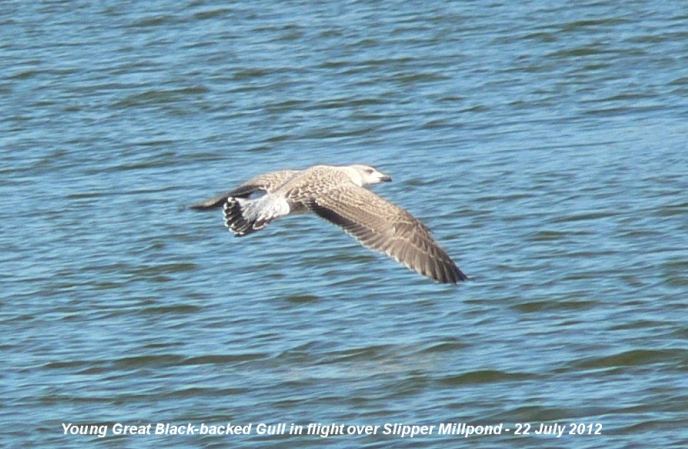
The Cormorants have
now taken back the centre raft, there were 5 on there
this afternoon. Interestingly, the Coot pair were back
on the north raft tending to their nest after it was
temporarily taken over by the Great Black-backed Gull
chicks.
Brook
Meadow
This was a Skipper
afternoon on Brook Meadow, they were everywhere! I
have never seen so many on one occasion. They must be
having a good year? Most were Small Skippers, though I
did find one Large Skipper which flitted from
one Hedge Bindweed flower to another on the Lumley
area. I have not seen them feeding on bindweed before.

I also saw one likely
Essex Skipper with jet black tips to its
antennae.
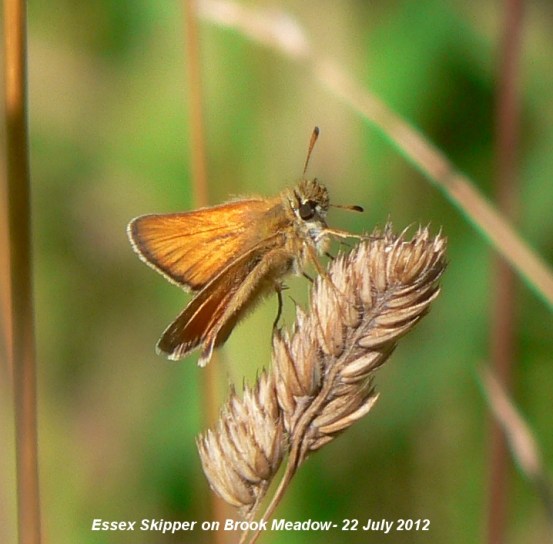
I also saw my first
Peacock butterfly for some while, an absolute
stunner.
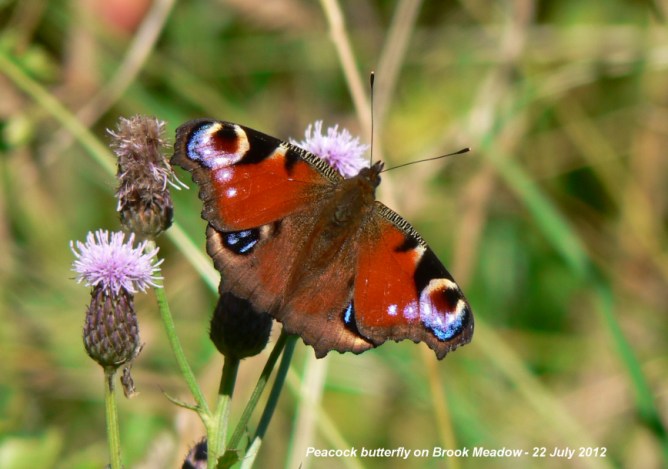
Hemp Agrimony
is showing the first signs of its pink flowers. They
should soon be out.
Nutbourne
First Teasels
of the year in flower on Nutbourne seawall.
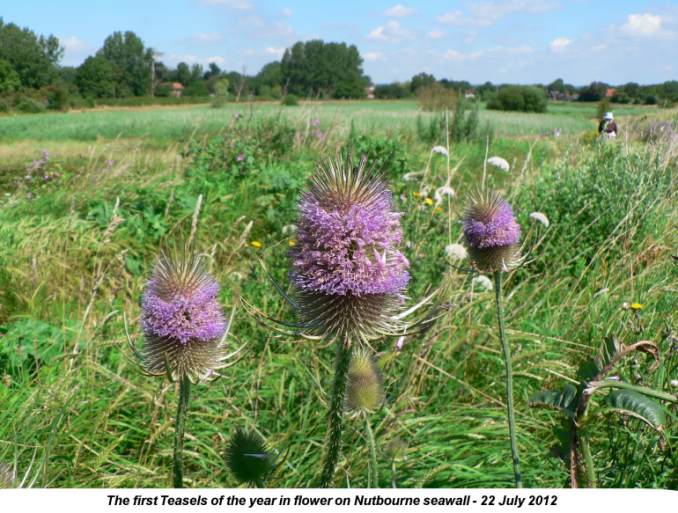
Thorney
Island
Richard Somerscocks
provided the following round up of his wildlife
highlights over the weekend on Thorney.
"I was down at Little
Deep both today and yesterday morning. Black-tailed
Godwits were in the harbour both mornings. I could
pick out colour-ringed W+WN yesterday but they were
impossible to count as they were in amongst all the
boats. Today they were in two distinct groups, one by
the channel in the centre of the harbour and the other
larger group closer to the shore in the eastern
harbour. In all there were 81. I couldn't however pick
out any colour ringed birds although the group closer
to me gave some good photo opportunities. Here is
Richard's photo of a group in flight.

In and around the
water at Little Deep there were a number of young
families. There was a Little Grebe with a chick, two
families of Mallard - one with 4 and the other with 5
ducklings, and a Tufted Duck with 6 ducklings. There
was also a Pochard this afternoon with the Tufted
Ducks.
On the reed beds there
were plenty of Reed Warblers , a few Sedge Warblers
and also Reed Buntings. On both mornings I have also
seen Bearded Tits. I also attach a picture of a
Warbler taken this evening in a birch just beside the
path at Little Deep. I wasn't certain what it was -
Reed or Cetti's Warbler?"
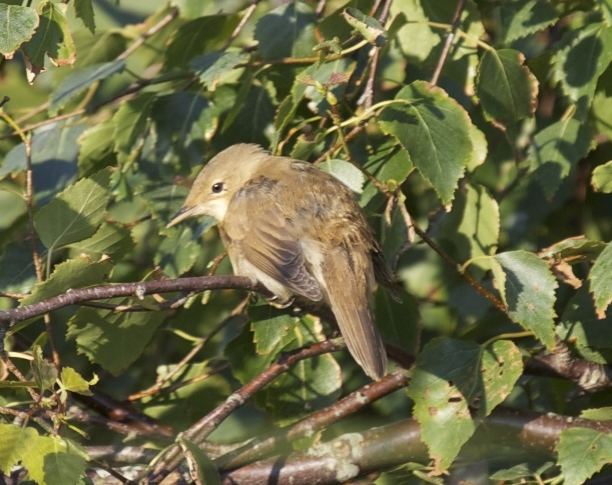
SATURDAY
JULY 21 - 2012
EMSWORTH
Slipper
Millpond
The two Great
Black-backed Gull chicks have now migrated to the
south raft. They have been on the north raft for the
past few days. One of the adult gulls was on the water
nearby. By my reckoning the chicks should be flying in
around 2 weeks.
The centre raft where
the original nest was has been given over to the
Cormorants.
Peter
Pond
I was pleased to hear
from Maurice Lillie that the family of 4 Coot
chicks was still alive. Maurice has been watching
them daily and marvelling at what good parents the
Coots are. He thinks the chicks are more disciplined
than ducklings and tend not to stray so far from adult
supervision. Coot parents are much stricter with their
youngsters than are Mallard. Maurice wonders why the
newly hatched cootlings have such brilliantly coloured
red plumage. I got the following photo I took of the
family near the Peter Pond seat this afternoon.
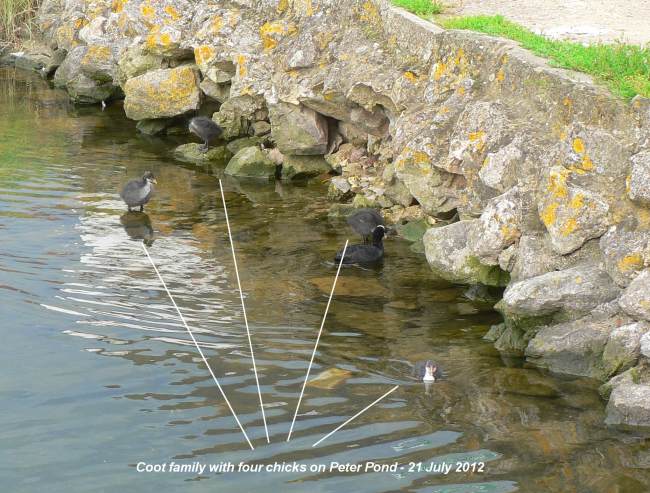
Walking past
Gooseberry Cottage I noticed a single flower of
Musk Mallow on the pond side of the track. This
plant comes up here every year, but never produces
many flowers

Brook
Meadow
Walking home through
Brook Meadow I put up a good number of butterflies,
mostly Meadow Browns, Gatekeepers and a Ringlet.
However, I did stop to look more closely at a Small
Skipper following Richard Somerscocks's finding of
an Essex Skipper yesterday. From the photo its
antennae tips are black, but not black enough, I
think, to make it an Essex Skipper. Compare the black
tips on the antennae of this insect with those on
Richard's insect yesterday.
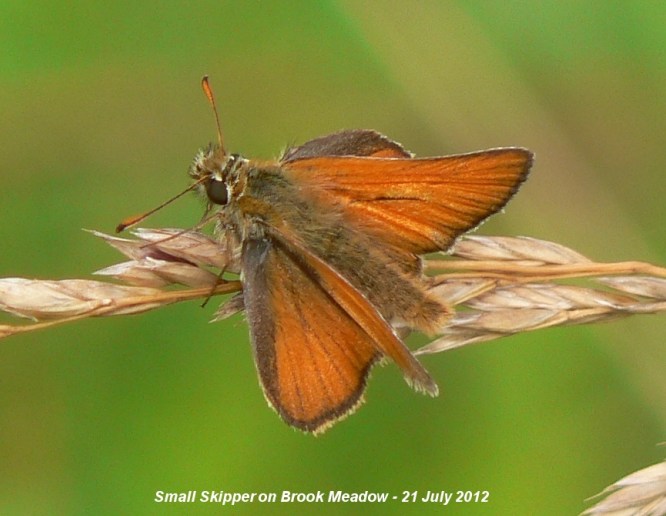
Tall
Fool's Parsley
Regarding the extra
large Fool's Parsley (Aethusa cynapium) currently
standing at around 8 feet tall on the Seagull Lane
patch of Brook Meadow (see yesterday's entry), Ralph
Hollins provided a technical reference to indicate
great variability in Fool's Parsley in life form,
size, position of branches, degree of leaf division,
pigmentation, length of peduncles, number of rays, and
size of bractlets. So I should not be too surprised at
variability!
Langstone
Harbour seabird breeding - a very poor season
Chris Cockburn
provides yet another gloomy report on the seabird
colonies: Harbour Islands: Breeding season is now
effectively over for the harbour islands with very few
birds out there. Productivity for all terns looks to
be zero (unless a few common terns on Round Nap defy
all the odds)
Hayling Oysterbeds:
Black-Headed Gull chicks continue to hatch and some
survive (a few two-week old chicks were seen); the
first of the Common Tern chicks should appear in the
next few days while the oystercatcher on south island
had one egg hatched today and, hopefully, have one or
two more eggs to hatch. The other Oystercatcher pair
(chicks hatched last Sunday) now have no
chicks.
Good news - very few
Med gulls seen or heard - hooray!
Bad news - with many
fewer gulls and terns at the site, carrion crows are
predating chicks (behaviour first noted last Sunday) -
they seem to have wiped out all chicks on north island
and are now concentrating on south island - I think
that only one particular crow family is involved with
their youngsters getting a high-protein diet - boo!
FRIDAY
JULY 20 - 2012
BROOK
MEADOW
It was a warm and
cloudy morning for my mooch around the meadow. I was
surprised at how quickly much of the meadow had dried
out, apart from the notorious hot spots on the north
meadow and around the "Lumley puddle".
One of the Fool's
Parsley plants on the Seagull Lane patch has grown
to a whopping 5 feet tall. The Hogweed are even taller
- some up to 8 feet tall. Field Bindweed is in flower
for the first time at the far end of the Seagull Lane
patch.
There are plenty of
red berries on the Alder Buckthorn below the
causeway and on the Rowans in Gwynne's plantation on
the east side of the north meadow. Hard Rush is
flowering well on the Lumley area.
The broad white
umbellifers of Hogweed provide popular mating and
feeding grounds for red Soldier Beetles, where they
had the company of some attractive yellow and black
Longhorn Beetles (Strangalia maculata).
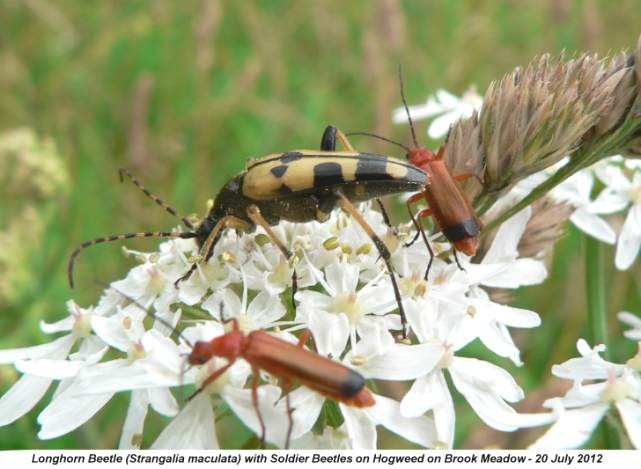
A Gatekeeper
perched conveniently displaying its attractive
underwings.
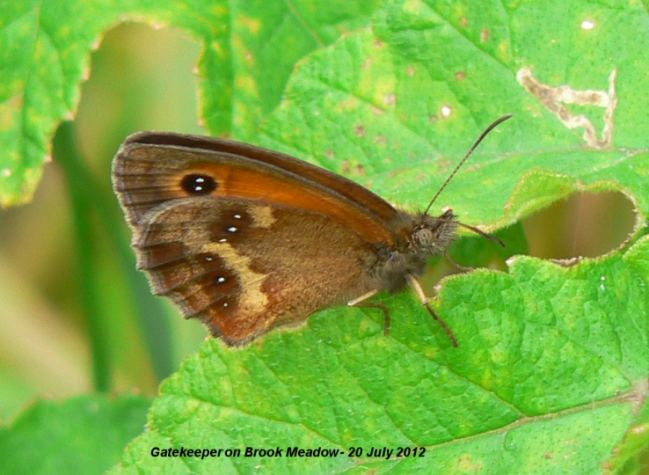
Richard Somerscocks
had a good afternoon on Brook Meadow, finding a good
variety of butterflies, including Gatekeeper, Meadow
Brown, Red Admiral, Comma, Marbled White, Green-veined
White, Ringlet, Small Copper and Essex Skipper
which was a first for the year. Essex Skipper is
distinguished from the similar Small Skipper by the
black tips to their antennae and a more diffuse black
marginal border.
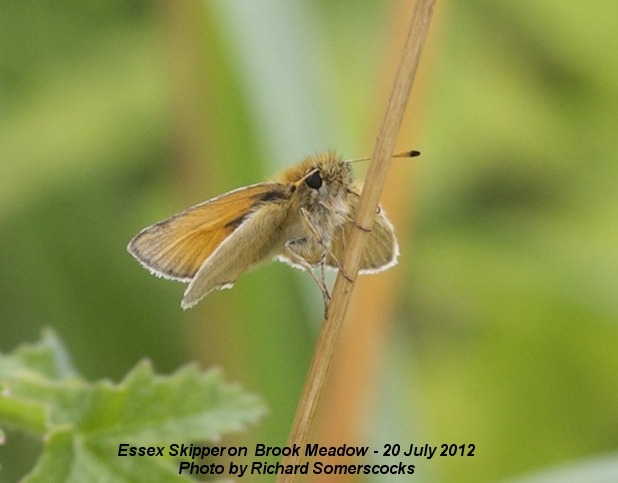
Richard also found an
unusual female Meadow Brown with two white pupils
in the oceli on the forewing, which the Gatekeeper
also has. However, the Gatekeeper is a much smaller
butterfly and has much more orange on its forewings
than any Meadow Brown.

MILLPOND
NEWS
Slipper
Millpond
The two Great
Black-backed Gull chicks were on the north raft
along with one of the adults. The other adult was on
the centre raft with 4 Cormorants. One of the chicks
went onto the water while I was there with much
splashing and flapping of wings. It looks as if the
chicks have left the nesting raft for good and are
waiting for flight to happen. Not much longer?
A single Swift
was hawking over the pond. I also saw two Swifts
flying over Bridge Road this morning, all birds
heading south on migration back to Africa.
Perennial
Sow-thistle is flowering well on the edges of
Slipper Millpond and Dolphin Lake , but not Golden
Samphire as yet.
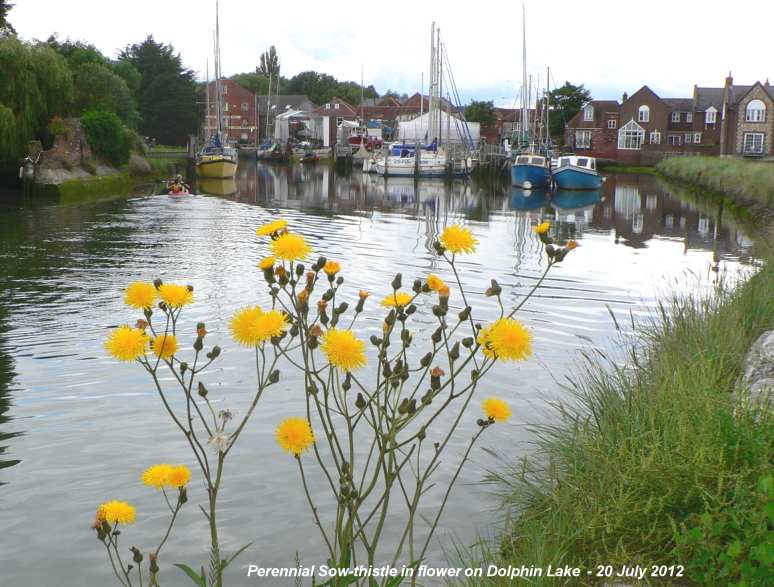
Sea Club-rush
is in full flower along the west bank of Slipper
Millpond. This has been successfully transplanted by
the pond association a few years ago to stabilise the
banks.
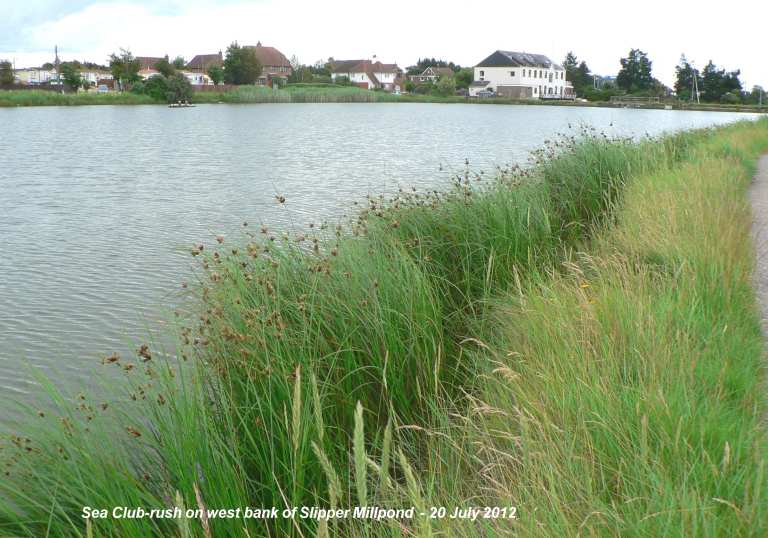
Peter
Pond
Two Coot chicks still
survive from the family of four that were on the pond
a week ago. A female Mallard also has two growing
ducklings. Hairy Tare with very small pale bluish
flowers, is flourishing along the path to Gooseberry
Cottage on the western side of Peter Pond, the best I
have ever seen it.
'White
slug' update
John Vickers e-mailed
to say the mystery 'creature' was still in the same
place on the dead tree on his back patio, but there
was no sign of yesterday's whiteness. "The whole body
has turned a darkish brown. To all appearances, quite
dead. I shall leave it there to se whether any birds
show interest, but I don't expect so."
That clinches it; the
mystery growth is clearly not a white Black Slug which
was my first guess. Ralph Hollins thinks it is more
likely to be a fungus growth, possibly an early stage
of one of the big brackets, but more likely
(especially as there is sign of slime) to be a stage
in the development of a Slime Mould when all the
individual cells have come together to form a Coral
like single organism. Ralph provides a link to the
slime mould Enteridium lycoperdon which looks very
much like John's growth. . . . http://en.wikipedia.org/wiki/File:Enteridium_lycoperdon,_(Bull.)_M.L._Farr,_1976_(Reticularia_lycoperdon).JPG
Ralph also refers to
the section of http://en.wikipedia.org/wiki/Slime_mold
which deals 'Plasmodia'. If John's growth is a slime
mould in its plasmoidal stage the whole organisim
could move in a very slow slug like fashion.
THURSDAY
JULY 19 - 2012
EMSWORTH
Slipper
Millpond
15:00 - There was not
much change from yesterday. The two Great
Black-backed Gull chicks were both on the north
raft snoozing, one of the adults was on the centre
raft with two Cormorants and the other adult gull was
perched on the nest box on the south raft. So, the
Great Black-backed Gulls rule the pond. Full stop!
Hollybank
Woods
16:00 - I had a quick
walk through the woods hoping for a White Admiral, but
apart from a couple of Meadow Browns I saw no
butterflies at all. The most interesting observation
was the bushes of both white and pink flowering
Musk Mallow on the old Holly Lodge clearing.
Richard Somerscocks had previously reported them on
July 8. I have not previously recorded Musk Mallow in
Hollybank Woods. So, where have they come from?
Westbourne
Open Space
It was a joy to walk
through the grasses on this wayside, dominated by the
very delicate inflorescences of Creeping Bent-grass
and the cylindrical spikes of Timothy and Smaller
Cat's-tail. There was no mistaking the difference in
size between these two similar grasses. The grasses
were overlooked only by the tall flowers of Common
Ragwort and the reddish spikes of Broad-leaved Dock. I
found a good patch of Perforate St John's-wort in
flower for the first time. Lots of red Soldier Beetles
were on the site, many of them in flight. A flock of
about 10 Swallows were skimming over the mown
grassland on the east side of the cycleway.
White
Black Slug?
Jon Vickers e-mailed
me to say he had a strange white creature on a dead
tree in his back garden patio in the centre of
Emsworth. I went round to have a look and take some
photos. I have never seen anything like it. It was
slug-like, but all white, and did not appear to have
any head! It was soft to the touch, but not as slimy
as a normal slug. It did not respond when I prodded
it. There were a few tell-tale traces of slime around
it, though John had not seen it move. It was about 2
inches (5cm) in length
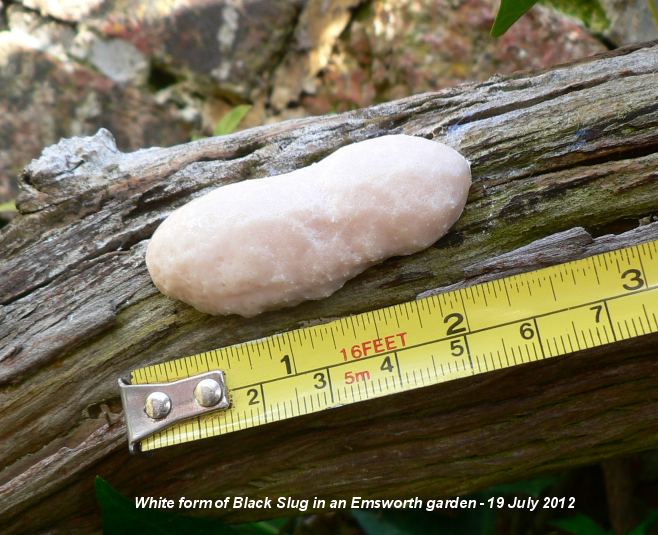
One possibility is
that it is a white form of a Black Slug (Arion ater).
Wikipedia states although the colour of the Black Slug
is generally black, colouration is very variable and
it can even be white. There is a photo of a white form
of Black Slug on the Wikipedia web page. The Black
Slug is mainly nocturnal which probably accounts for
the torpidity of John's slug. It also prefers moist
conditions, such as lawns, but John's slug was on dry
branch of a dead tree, again not ideal for its
locomotion.
Does anyone else have
any idea what it might be? Maybe, it is not a slug at
all? I have asked John to keep an eye on it let me
know if it moves.
Crab
Spider
Tony Wootton captured
this image of a white coloured Crab Spider with a
Meadow Brown butterfly as its prey. Crab Spiders are
predatory, waiting on flowers for insects to land,
which they then immobilize and consume. This butterfly
was quite a feast! Photo taken at Denmead this
morning.
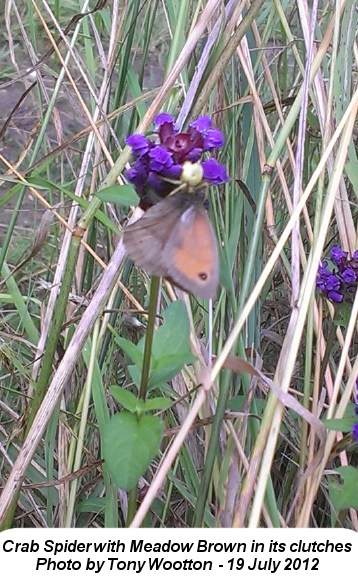
Langstone
Harbour breeding news
Chris Cockburn reports
on a pretty poor breeding season to date:
Nest counts:
RSPB Islands 23/24 May: Mediterranean Gull 58
Black-Headed Gulls 3643. Sandwich Tern 45, Common Tern
74 Little Tern 26.
Oysterbeds 30 Apr & 25 May: Black-headed gull 1039
Sandwich Tern 1 Common Tern 17
Fledging up to 17
July:
RSPB islands: Mediterranean gull 2 Black-Headed
Gull 11
Oysterbeds: Black-Headed Gulls 67
Present
outlook:
RSPB islands: at least 2 Common Terns re-nesting
and potential for some Black-Headed Gulls to be
re-nesting (but vegetation too dense for nests to be
seen). No Little Terns nesting but c30 birds roosting
on South Binness. If all goes well (weather, tides and
Mediterranean gulls leaving the harbour) the season
could continue until early September!
Oysterbeds: c80
re-nesting Black-Headed Gulls (hatching started on 07
July). c50 re-nesting Common Terns (nesting started on
20 June and continues - 1st hatch expected c20 July)
At Oysterbeds, one Oystercatcher chick was seen on 15
July and another pair should have their eggs hatching
c19 July
English
summer is over for our Cuckoos
BTO reported "Twelve
of our thirteen male Cuckoos have already left the UK
and Chris has become the first of the tagged Cuckoos
to arrive in Africa this year! Lyster, the last to
leave in 2011, headed off twelve days earlier than
last year, probably as tired of the poor weather as
the rest of us! All the Cuckoos are now named, with
Roy, Lloyd and John joining the ranks. Wallace is the
only male remaining in the UK, while the others appear
to be preparing for their southward crossing, as they
line up on the northern edge of the Mediterranean,
between the extreme east of the French Mediterranean
coast and Montenegro. Find out more on the blog . .
http://bto-enews.org/IG4-VKOX-3RN36S-C8Z8X-0/c.aspx
WEDNESDAY
JULY 18 - 2012
PORTSMOUTH
Fort
Cumberland
I had a walk around
the open area to the west of Fort Cumberland on a very
windy morning with rain constantly in the air. A new
interpretation board has been installed since my last
visit in May 2011 and the site is now called Fort
Cumberland Open Space (SINC). This is the largest area
of natural coastal heathland in Portsmouth which
developed on a large stable shingle bank. Looking
across the site, one's impression was of an area
ablaze with wild flowers, creating a rich kaleidoscope
of colours. The yellow of Fennel contrasting with the
bright pink of Common Mallow, and the deep blue
Viper's Bugloss scattered among yellow swathes of
aromatic Ladies Bedstraw. It was a joy to walk through
the area despite the wind. Highly recommended!
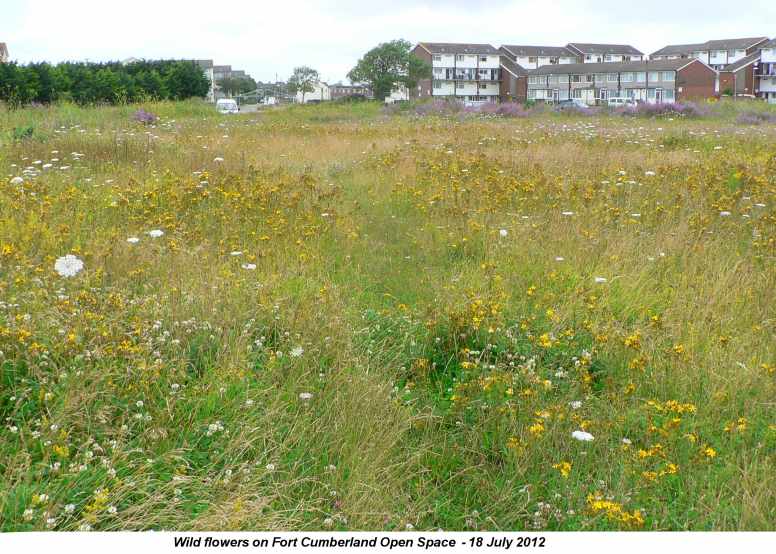
The Harebells
were far more abundant than I recall on my previous
visits with some good patches of them in flower along
the northern path. The flowers looked like regular
Harebells, not the large variety that I used to find
there in the early 2000s. I also found a small amount
of Sheep's-bit along this path.
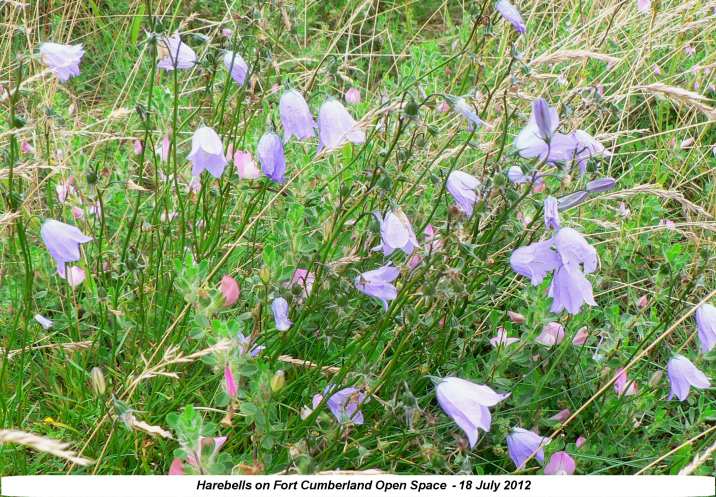
Other plants in flower
that caught my attention were Wild Carrot, Bristly
Ox-tongue, Perforate St John's-wort, Common Ragwort,
Wild Radish, Bird's-foot Trefoil, Crow Garlic,
Hare's-foot Clover, Restharrow, Oxeye Daisy, Common
Centaury, Red Clover, White Clover, Buckshorn
Plantain, Yarrow and Smooth Hawk's-beard, Black
Medick, Mugwort. Tansy grows along the path to the
beach, not quite in flower. Not many butterflies were
on the wing, but I did have my first Small Skipper of
the year.
Eastney
Beach
I walked along the top
path overlooking the caravan park. Here I found a good
quantity of Lucerne in flower plus a single Sea
Holly which I previously saw in the same spot in
flower in November 2007. It was not in flower today,
but looked healthy and I must try to get back here to
see it flowering.
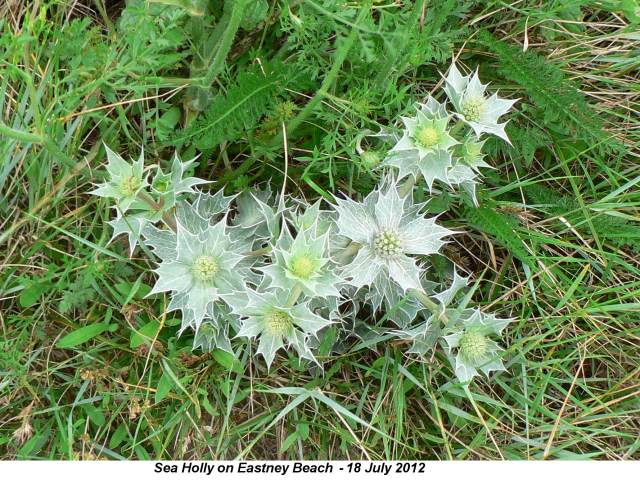
Plants in flower on
the shingle beach included White Melilot, Red
Valerian, Silver Ragwort (one bush), Yellow-horned
Poppy, Oxford Ragwort, Cat's-ear,
I saw just one
Mediterranean Gull among the Black-headed Gulls on the
beach.
Baffins
Pond
The Canada
Geese are assembled as usual on the pond for their
annual moult, but not in the numbers there used to be
when I did regular bird counts on the pond. I counted
just 80 on the pond today, whereas my July counts from
1992 to 2005 never fell below 100 and were a massive
198 in 2002.
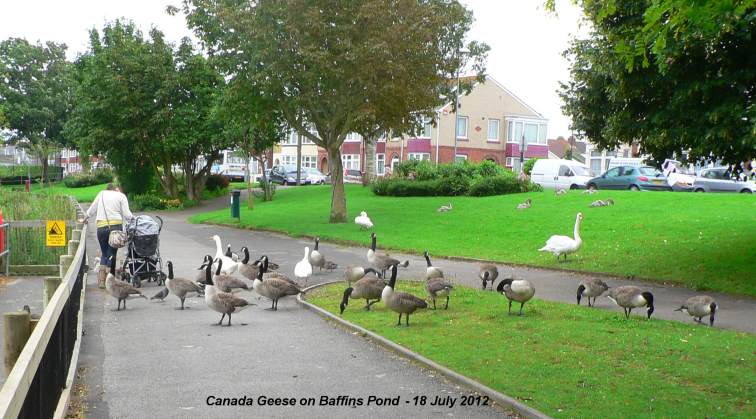
One reminder of the
'good old days' was the presence of two Barnacle
Geese, but again nowhere near the 42 there were on
the pond in 1998-99. The two regular Embden Geese were
with the Canadas.
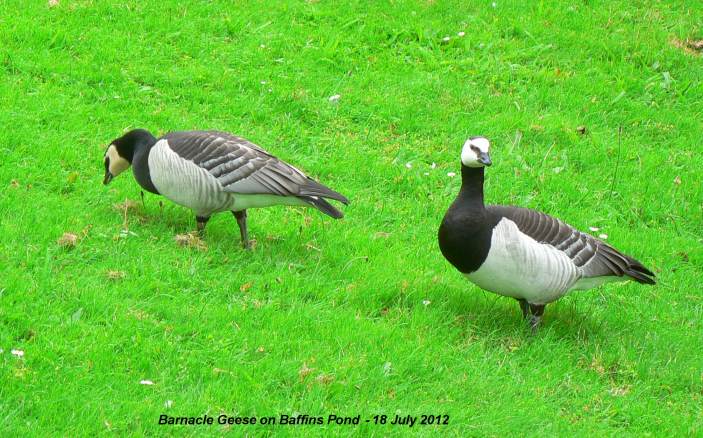
However, the Mute
Swan pair have broken all my old records for
Baffins Pond as they were on the southern verge with
no less than 7 cygnets. I think 5 was the most I ever
recorded. Some of the family can be seen in the
background in the Canada Geese photo above. All I
could see on the main island were 1 Cormorant, 1 Grey
Heron and 1 Little Egret.
I was interested to
see the five newly created wetland areas to the east
and south of the pond which are starting to look very
good indeed. A complete transformation from the rather
barren edges there used to be.
EMSWORTH
Great
Black-backed Gulls
I had an e-mail from
Patrick Murphy who went down to Slipper Millpond this
morning to see the Great Black-backed Gulls and found
that chicks had moved onto the north raft. I had a
look for myself this afternoon in between the showers
and found the chicks still on the north raft.
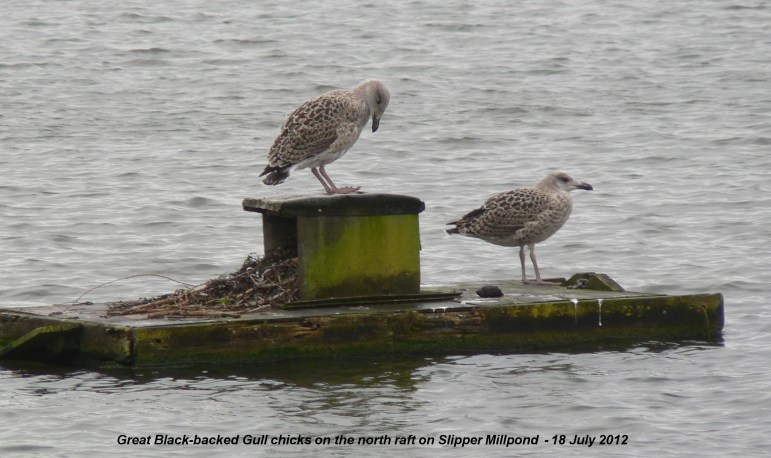
One of the adult gulls
was on the centre raft with two Cormorants. I waited
for about 30 minutes to see if anything happened.
While I was there one of the chicks flew a couple of
metres from the raft onto the water and spend the next
15 minutes swimming around, making occasional brief
flights of about 2-3 metres, before coming back onto
the raft. The other chick remained on the raft the
whole time. I reckon the two chicks made their way to
the north raft by a mixture of swimming and flapping.
But they can't be far away from proper flight.
Mystery
mammal
Patrick Murphy saw
what he thought was a shrew or a vole on the main path
through the south meadow of Brook Meadow. Patrick got
a quick shot at it as it dived into the foliage at the
side of the path. There is not much to go on in the
photo, but the way the head narrows towards the snout
suggests Common Shrew to me.
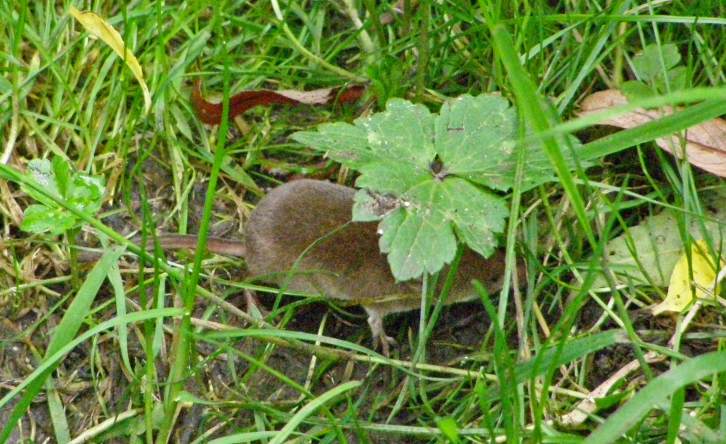
Strawberry
Tree deaths
In response to my news
about the deaths of two prominent Strawberry Trees in
Emsworth over the past year, Lesley Harris tells me
they had a beautiful Strawberry Tree in their front
garden, which after five years suddenly gave up the
ghost and died. It's a great sadness the magnificent
specimen beside Slipper Millpond is going the same
way. I agree. Maybe the hard winter finished them off?
They are only native in Western Ireland where the
climate is very mild.
GODWIT
NEWS
Pete
Potts reports on his trip to Iceland
"The godwit team
returned from Iceland on Sunday after 2 weeks of field
work. Our team consisted of 10 people with some
turnover - with participants from The Netherlands,
Ireland, UK plus help from various Icelanders. Iceland
has had a good summer with little rain and plenty of
sunshine which has helped the breeding season in some
areas, it was certainly a much better season than
2011. However, in some core areas very few pairs were
found with chicks, no fledged chicks and no flocks
were seen on fields suggesting an early departure. We
ringed a record number of wader and arctic tern chicks
a total of c.410 of 10 species of wader. Arctic Terns
have had a good breeding season for the first time for
ages.
We colour-ringed 115
godwit chicks (with our new yellow flag scheme) and 38
adults in two catches (using the last of the X scheme
and the 8 scheme). Jose Alves has also colour-ringed
c.50 chicks and 20 adults on his study sites in SW
Iceland. So plenty more ringed godwits to look out
for.
We logged c.45
colour-ring sightings mainly godwits including our
birds from the Solent (2), Portugal (2), Brittany (1),
N Ireland (1) also birds from the Wash (1) and
Iceland. Also colour-ringed Ringed Plovers, Redshanks
and Whooper Swan."
TUESDAY
JULY 17 - 2012
SLIPPER
MILLPOND
Great
Black-backed Gulls
15:00 - The centre
raft was rather crowded this afternoon (3pm) with the
male Great Black-backed Gull and the two growing
chicks accompanied by no less than 7
Cormorants.

The adult gull was
clearly not entirely happy with the situation and
spent much of the time constantly giving its croaky
call, presumably to alert its mate to the growing
crowd. I did witness one skirmish in which the adult
gull chased a juvenile Cormorant over the pond,
getting very close to it at times, but not actually
catching it. After a couple of minutes it abandoned
the chase and went back to the raft.
Plants
I noticed Fennel
flowering on the east side of the pond. There are many
clumps of Lesser Sea-spurrey now flowering
nicely along the edges of the path leading to the
western kissing gate.
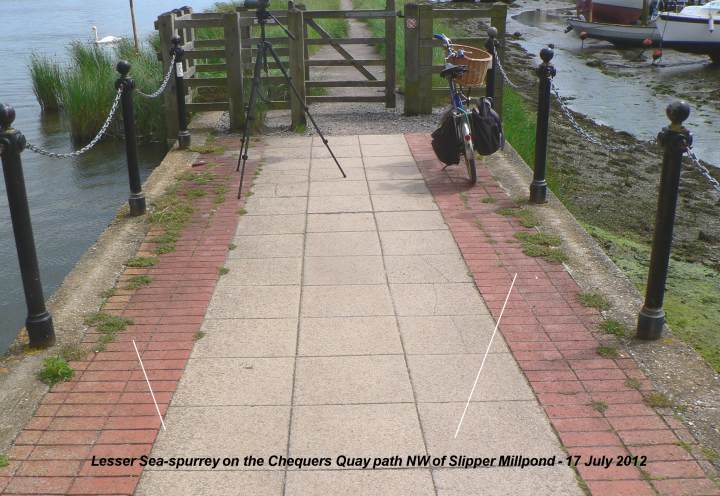
EMSWORTH
HARBOUR
Black-tailed
Godwits
15:30 - I got to the
Wickor Bank about 4 hours after high water; the tide
was already well out and godwits were feeding in small
groups on the mudflats and in the small channels. Most
were still in their summer plumage and looked quite
splendid. The conditions were reasonably good except
for a brisk SW wind blowing straight into my face!
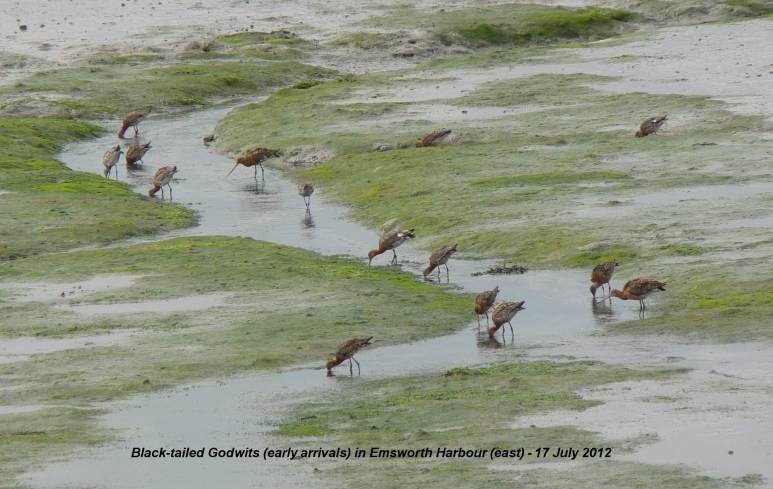
I counted a maximum of
74 Godwits including three colour-ringed
birds:
O+YL
- A regular winter visitor to the
Fishbourne-Bosham harbours for many years (since
2006), but this was my first ever sighting in
Emsworth. My last sighting of it was on 10-Jan-12 in
the Bosham Channel. This was the earliest record for
this godwit.
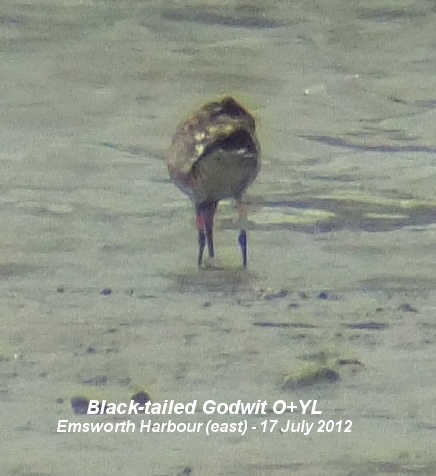
W+WN
- First
recorded in Emsworth Harbour on 18-Oct-10. It was very
regular in Emsworth last winter with a total of 41
sightings from 21-Jul-11 to 11-Feb-12.

W+RY
- I am not 100% certain about this combination. The
white ring could possibly be yellow. However, W+RY was
recorded just once last winter on 14-Aug-11 in
Emsworth Harbour (east) by Richard Somerscocks. We did
not see it again. If this is W+RY it could be a
passage bird that just drops into Emsworth on its way
to winter elsewhere.
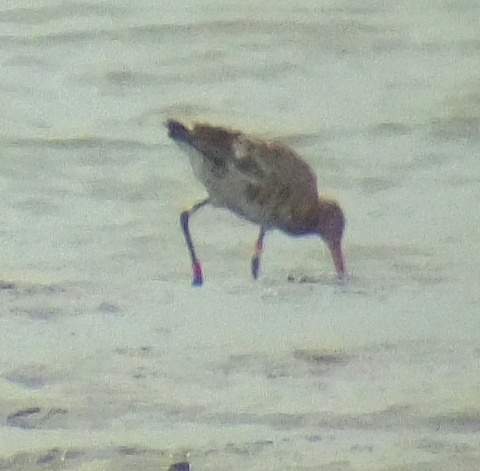
Richard Somerscocks
went to the harbour later in the afternoon when the
tide was low and counted 76 Black-tailed Godwits from
the millpond seawall. They included
R+RN
which he also saw yesterday. He was certain on the
combination today. So that means we have at least four
colour-ringed godwits back in Emsworth, at least
temporarily.
Richard also spotted
Greenshank RO+NY, which he also saw in the harbour
last August.
MONDAY
JULY 16 - 2012
Godwits
in Emsworth Harbour
Richard Somerscocks
had a quick look at the Black-tailed Godwits in the
eastern harbour this evening at 6pm. There were
similar numbers to yesterday - 67 this evening. There
were also 3 colour-ringed birds. The viewing
conditions were poor and Richard's photos not
conclusive. We shall need to look at them again in
better conditions.
R+RN - I have two
records from last winter in the Bosham-Nutbourne
areas. Richard in fact got a photo of R+RN at Bosham
on 23-Oct-11.
G+GG - There have been
several sightings of this one over the years, the most
recent I have is in Fishbourne Channel on 05-Oct-10.
Richard also spotted
Greenshank L+WY which has been fairly regular in
Emsworth Harbour over the years.
Colin
Vanner at Farlington
We have not heard much
from Colin for some while, but he managed to get down
to Farlington Marshes on what was the only fine day we
have had for months (or so it seems). He returned with
some smashing photos to share with us.
Here
is a Short-eared Owl hiding in the long grasses
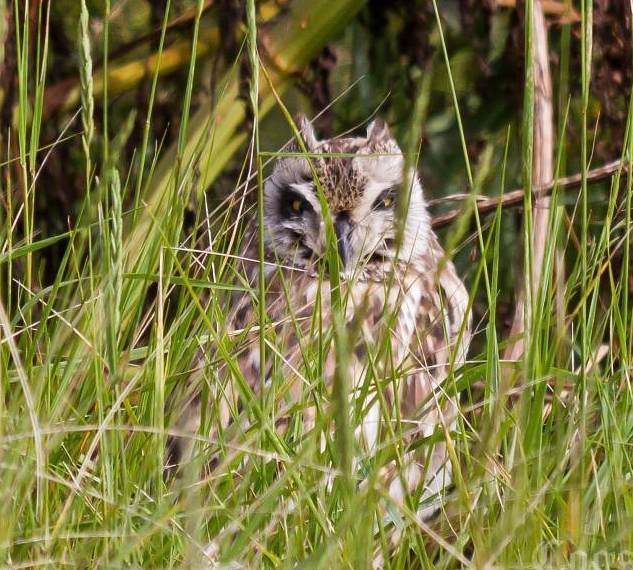
and a
Meadow Pipit
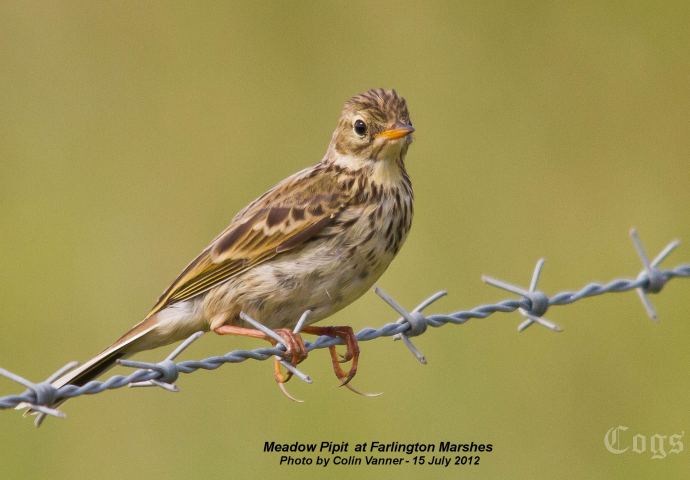
and a
family photo of Little Grebe and chick
